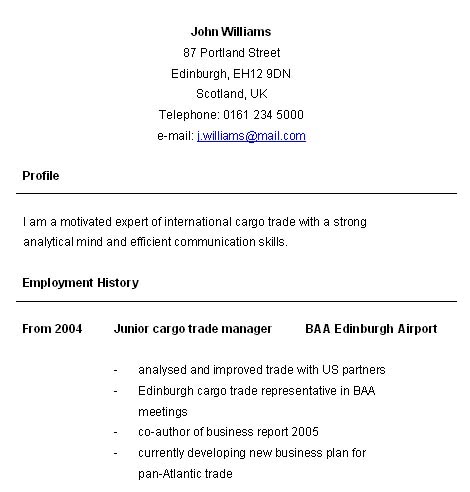|
|
|
Chronological CV
|
A chronological CV is commonly used and widely recognized. Subdivided in a number of fixed categories, it emphasises your employment history by stressing when you did what. This format is a good option when your career goals are clearly defined and when your career has been steadily progressing. It is not suitable if you do not want an employer to notice that you have limited experience.
When to use - Your recent career history is impressive and shows significant growth/progress.
- You want to stay in the same or a related career field.
When not to use - You have changed careers/employers frequently. The frequent shifts would be overstressed in a chronologigal CV.
- You want to de-emphasize age.
- You have been recently absent from the job market.
| Advantages | Disadvantage | - Easy to organise.
- Familiar.
- Makes a stable impression if you have been in one organization long enough and you have had a number of promotions.
- Highlights progress and an increase in responsibilities.
| - Job-hopping is clearly visible in this format, which sometimes makes a bad impression.
| Content The CV should always start with your personal details. The other headings can be listed according to the importance given to them in the job ad. If the job ad stresses experience, mention your employment history first, followed by education etc. Since most employers will be primarily interested in your most recent activities, the reverse chronological order is often the most advisable one. Still, when you want to highlight something which happened some years ago, it can be useful not to list the most recent, but the most relevant event first. Whether you use the chronological or the reverse chronological order in your CV, gaps will show. If your cv shows time lapses, do not try to conceal them, but rather prepare for questions about them during the interview. Below you can find more information about the different components of a chronological CV. For more in-depth information, check the CV sections in the left column. Content 1. Personal information - name and surname
- address
- e-mail
- phone number
- optional: date of birth, nationality, marital status, age, gender, date of availability
2. Profile Especially when there is no room for a cover letter (e.g. online forms), people like to include a profile in their CV. In this section you briefly state what kind of person you are and what skills you have. The more you adjust your profile to each individual job the better. 3. Professional experience / career history Include the following: - job title
- start and end date
- name and location of employer
- optional: tasks and assignments, accomplishments
4. Qualifications/Education Use the reverse chronological order and provide the following information: - name of the program
- start and end date of the program
- name and location of the school
If relevant, you can include major courses and dissertations, but be brief with information about education if experience is more important. 5. Other skills Use the "Skills" section to highlight skills and abilities that might otherwise go unnoticed. 6. References Only include references if asked for. Note that a reference can refer to a person as well as a document. For a full pdf-version of the chronological cv below, click the chronological CV 1 in the right column.  The video belows shows you how to read a job ad and process the information to create a custom made chronological CV.
Source
- Bright, Jim & Earl, Joanne (2001). Brilliant cv's. Prentice Hall. p. 69-76.
- Chronological CV's, Jobera
|
|
|
|
|